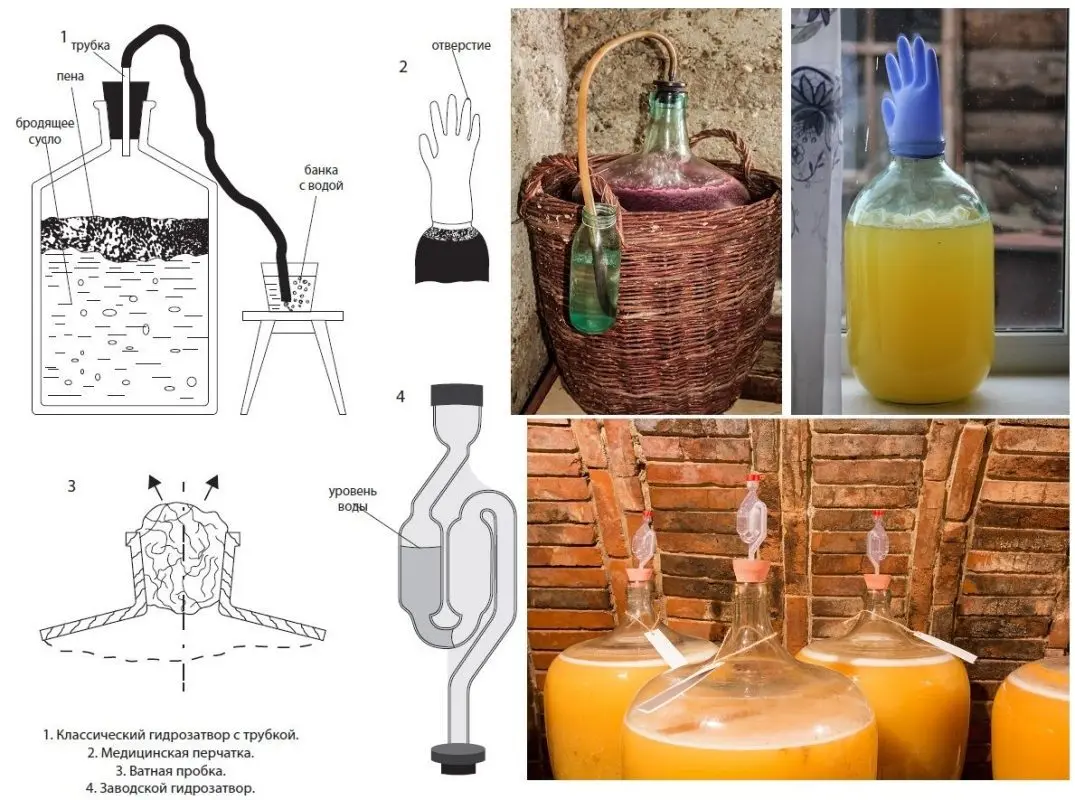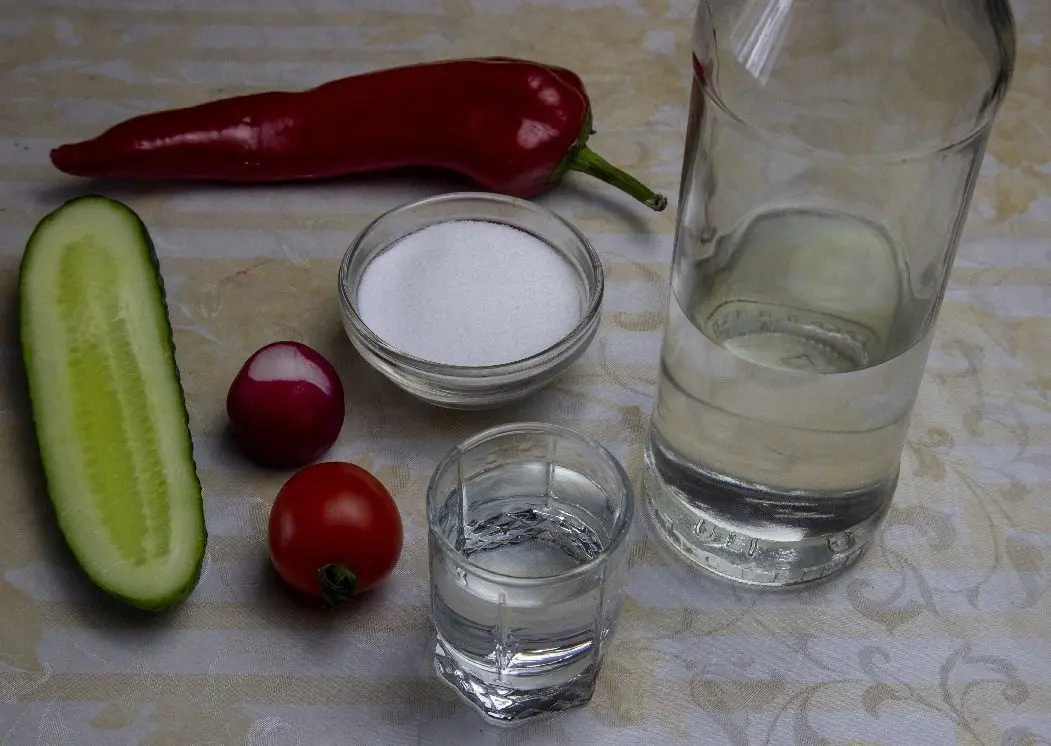Braga on enzymes is relevant for any starch-containing raw materials. With the right approach, moonshine turns out to be cheaper and much better than sugar, even considering that you need to buy enzymes.
Theory
Yeast can process only simple sugars – glucose and fructose into alcohol, therefore, when working with starchy raw materials, you first need to break down starch into simple sugars, the process is called saccharification.
Starch can be separated by two methods: using malt (sprouted grain) or synthetic enzymes. Malt saccharification has been around for a long time and is considered a traditional method, but requires a lot of labor and precise temperature control. Working with enzymes is as easy as regular sugar or fruit brew, but fermentation takes longer (12-24 days versus 5-10 days), although there is a trick to speed up fermentation, it is described in the recipe.
In terms of the quality of fermented moonshine compared to regular malt, most people do not feel the difference and, in blind tasting, cannot distinguish one drink from another.
Any starch-containing raw materials can be sugared with enzymes: cereals (corn, barley, wheat, buckwheat, rice, oats, etc.), potatoes, flour, and even pure starch. Grain and potatoes must first be crushed (only polished rice, barley and millet can be used whole), flour and starch are poured immediately.
To obtain moonshine, two enzymes are used: Amylosubtilin (enzyme A) and Glukavamorin (enzyme D). The first divides the starch molecule into several small ones, and the second turns them into simple sugars.
Enzymes do not reduce the yield of moonshine, the amount of drink depends on the starch content in the raw material. It should be borne in mind that the table indicates theoretical values, in practice the yield is usually lower by 10-15%.
| Raw materials | Alcohol, ml/kg |
|---|---|
| Wheat | 430 |
| Barley | 350 |
| Rye | 360 |
| Corn | 450 |
| Oat | 280 |
| Peas | 240 |
| Millet | 380 |
| rice | 530 |
| beans | 390 |
| Potatoes | 140 |
| Starch | 710 |
| Sugar | 640 |
Enzymes for moonshine are sold in special stores for moonshine. When choosing, you should take into account the expiration date, the “fresh” enzymes, the better.
Enzyme brew recipe
Ingredients:
- any starch-containing raw materials – 5 kg;
- water – 18 l;
- Amylosubtilin – 10 g;
- Glucavamorin – 15 g;
- yeast – 100 g dry (500 g pressed), or alcohol according to the instructions on the bag for 25 liters of wort;
- antibiotic – 150-200 ml (optional).
Theoretically, you can mix different types of raw materials, but then the aroma and taste of moonshine will not have any obvious notes. The optimal hydromodulus (ratio of raw materials and water) for mash on enzymes is 1: 3.5.
The dosage of enzymes is indicated by the manufacturer on the packaging, but is intended for pure starch. In order not to recalculate grain and flour into pure starch, enzymes can be added in the following proportions (per 1 kg of raw materials): enzyme A – 1-2 grams, enzyme D – 2-3 grams. The closer to the end of the expiration date, the more enzymes are required. Do not be afraid of an overdose, the concentration of enzymes does not affect the quality of the mash, after distillation they still do not get into the moonshine.
It is advisable to use alcohol yeast, if it is not available, dry or pressed baker’s yeast will do.
Braga on enzymes is at an increased risk of infection with pathogenic microflora. Therefore, some moonshiners use antibiotics for home brew. Advantages, disadvantages, suitable antibiotics and dosages are described here.
To speed up fermentation and reduce the risk of infection, fermented mash can be put with the so-called “hot start” – in heated water. In this case, the enzymes will quickly release all the sugars and fermentation will be fast, and the high temperature will destroy all pathogenic bacteria and fungi, so there is no need to add antibiotics.
Technology of preparation
1. For a “hot start”: bring water to a boil, then in small portions, stirring constantly, add crushed grain, flour or cereal. It is important that the raw materials do not burn at the bottom and near the walls of the pan. When the wort becomes homogeneous, turn off the heat and wait until it cools down to 80 °C. Add enzyme A, mix. Wait until it cools down to 65 °C and add enzyme G, then mix again. Cover the must with a lid and leave for 3-4 hours to saccharify (the temperature must drop to 30 ° C, otherwise the yeast will die). Pour the wort into a fermentation tank and pitch the yeast.
For a “cold start”: pour raw materials into a fermentation tank, pour in water, mix. Add enzymes, yeast and antibiotic (optional), mix again.
In both cases, you can fill the fermentation tank to 70% of the volume. The fact is that enzyme mash foams a lot, so there should be enough space for foam.
2. Transfer the fermentation container to a dark room (or cover with a thick cloth) at room temperature. Install a water seal of any design on the neck. Leave until the end of fermentation. If possible, for the first 5-6 days, it is advisable to shake the mash every 12 hours without opening the lid.

With a “cold start”, the mash ferments on enzymes for 12-24 days, with a “hot” start – 5-12 days. The exact fermentation time depends on the yeast and the temperature. The washed mash stops emitting gas from the water seal (the glove deflates), and a layer of loose sediment appears at the bottom.
Distillation
Braga on enzymes is better to distill with a steam generator, then there is less risk of burning.
3. If there is no such device, then the mash that has won back must be drained from the sediment into the distillation cube and the first distillation should be done at maximum speed without separation into fractions. Withdraw the product until the strength in the jet falls below 18% vol. Moonshine will turn out cloudy, this is normal.
4. Measure the strength of the resulting drink. To determine the amount of pure alcohol, for this, multiply the volume in liters by the strength in percent and divide by 100.
5. Dilute the distillate with water to 18-20% and make a second distillation. Collect the first 8-12% of absolute alcohol separately. This harmful fraction is called “head” and drinking it is dangerous to health.
6. Select the base fraction (“body”) until the strength in the jet drops below 40%. Then finish the distillation or collect the “tails” separately for adding to a new batch of mash or for processing in a distillation column.
7. Dilute the resulting moonshine (“body”) to a drinking strength of 40-45% vol. Pour into a glass container, close tightly and leave for 2-3 days to stabilize the taste.










